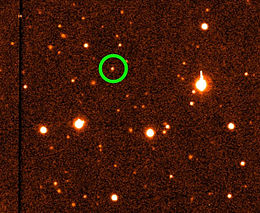90482 Orcus
 |
|
| Discovery | |
|---|---|
| Discovered by |
M. Brown, C. Trujillo, D. Rabinowitz |
| Discovery date | 17 February 2004 |
| Designations | |
| MPC designation | 90482 Orcus |
| Pronunciation | /ˈɔːrkəs/ OR-kəs |
|
Named after
|
Orcus |
| 2004 DW | |
|
Plutino possible plutoid |
|
| Adjectives | Orcean |
| Orbital characteristics | |
| Epoch 13 January 2016 (JD 2457400.5) | |
| Uncertainty parameter 2 | |
| Observation arc | 23439 days (64.17 yr) |
| Aphelion | 48.073 AU (7.1916 Tm) |
| Perihelion | 30.866 AU (4.6175 Tm) |
| 39.469 AU (5.9045 Tm) | |
| Eccentricity | 0.21799 |
| 247.97 yr (90571.28 d) | |
| 174.67° | |
| 0.0039748°/day | |
| Inclination | 20.564° |
| 268.570° | |
| 72.977° | |
| Known satellites | Vanth (276±17 km, assuming equal albedo) |
| Earth MOID | 29.9158 AU (4.47534 Tm) |
| Jupiter MOID | 26.2355 AU (3.92477 Tm) |
| Physical characteristics | |
| Dimensions | 917±25 km |
| Mass | (6.41±0.19)×1020 kg (system) |
|
Mean density
|
1.53+0.15 −0.13 g/cm3 |
|
Equatorial surface gravity
|
≈ 0.18 m/s2 |
|
Equatorial escape velocity
|
≈ 0.41 km/s |
| 13.188 h | |
| 0.231+0.018 −0.011 |
|
| Temperature | < 44 K |
| (neutral) B−V=0.68; V−R=0.37 |
|
| 19.1 (opposition) | |
|
2.31±0.03 (integral), primary: 2.41±0.05 Vanth: 4.88±0.05 2.2 |
|

Vanth could easily be 1/3 to 1/2 the diameter of Orcus
|
|
| Discovery | |
|---|---|
| Discovered by | Mike Brown and T.-A. Suer |
| Discovery date | 13 November 2005 |
| Designations | |
| Pronunciation | /ˈvænθ/ |
| S/2005 (90482) 1, Orcus I |
|
| Adjectives | Vanthian |
| Orbital characteristics | |
| 9030 ± 89 km | |
| Eccentricity | 0.007 ± 0.003 |
| 9.5406 ± 0.0004 days | |
| Inclination | ±21° |
| Satellite of | Orcus |
| Physical characteristics | |
| Dimensions |
378±100 km (Vanth's albedo of 0.12) 276±17 km (assuming equal albedos) |
| Mass | 2–6 × 1019 kg |
|
Mean density
|
≈ 1.5 g/cm3 |
| ≈ 0.11 m/s2 | |
| ≈ 0.447 km/s | |
| synchronous | |
| Albedo | ≈ 0.12 |
|
Spectral type
|
moderately red (optical) |
| 21.97 ± 0.05 | |
| 4.88 ± 0.05 | |
90482 Orcus is a Kuiper belt object with a large moon, Vanth. It was discovered on February 17, 2004 by Michael Brown of Caltech, Chad Trujillo of the Gemini Observatory, and David Rabinowitz of Yale University. Precovery images as early as November 8, 1951 were later identified. It is probably a dwarf planet.
Orcus is a plutino, locked in a 2:3 resonance with Neptune, making two revolutions around the Sun to every three of Neptune's. This is much like Pluto, except that it is constrained to always be in the opposite phase of its orbit from Pluto: Orcus is at aphelion when Pluto is at perihelion and vice versa. Moreover, the aphelion of Orcus's orbit points in nearly the opposite direction from Pluto's, although the eccentricities and inclinations are similar. Because of these similarities and contrasts, along with its large moon Vanth that recalls Pluto's large moon Charon, Orcus has been regarded as the anti-Pluto. This was a major consideration in selecting its name, as the deity Orcus was the Etruscan equivalent of the Roman Pluto, and later became an alternate name for Pluto.
The surface of Orcus is relatively bright with albedo reaching 30%, grey in color and water-rich. The ice is predominantly in crystalline form, which may be related to past cryovolcanic activity. Other compounds like methane or ammonia may also be present. The existence of a satellite allowed astronomers to determine the mass of the system, which is approximately equal to that of the Saturnian moon Tethys. The ratio of masses of Orcus and Vanth is uncertain, possibly anywhere from 1:33 to 1:12. The diameter of Orcus is estimated to be 761 or 807 km and the diameter of Vanth 378 or 267 km respectively, depending on their relative albedos.
...
Wikipedia
